
The Phoenicians: Mysterious Merchant Mariners Whose Inventions Impacted the World Forever
The Phoenicians were an ancient people who once ruled the Mediterranean. Despite little being known about them as very few of their inscriptions have survived, their legacy has had an enormous impact on the world, which is still felt today.
The Phoenicians were renowned as excellent mariners and used their expertise to trade all across the Mediterranean. One of the most notable signs of their trade activity is the establishment of Carthage, in present day Tunisia. They were also the inventors of the alphabet.
The History of the Phoenicians
According to tradition, the city was founded as a colony in 814 BC by Phoenicians under the leadership of the legendary Queen Dido. The Carthaginians themselves became a dominant maritime power in the western Mediterranean, until its final destruction by Rome in 146 BC, following their defeat in the Punic Wars. Apart from Carthage, the Phoenicians founded colonies on Cyprus and in Anatolia as well.
The greater part of the territory they once occupied corresponds to modern day Lebanon, but the Phoenicians also held parts of southern Syria and northern Israel.
The Phoenician Alphabet
The Phoenicians made numerous contributions to human civilization, the most notable of which being the Phoenician alphabet, which is the ancestor of many other alphabets that are used today.
Scholars have speculated that the Phoenicians referred to themselves as ‘Kena’ani’ (‘Kinahna’ in Akkadian, or ‘Canaanite’ in English). Interestingly, in Hebrew, this word also meant ‘merchant’, which is an apt description of the Phoenicians. The term ‘Phoenicians’, however, is commonly used today, as it was the Greeks who called these people by this name.
The ancient Greeks referred to the land of the Phoenicians as ‘Phoiniki’, which is derived from the Egyptian ‘Fnkhw’, meaning ‘Syrian’. The Greek ‘Phoiniki’ is phonetically similar to their word for the color purple or crimson (‘phoînix’). This is due to the fact that one of the most valuable objects produced and exported by the Phoenicians was a dye known as Tyrian purple. Thus, the Phoenicians were known also as the ‘Purple People’.
According to the Greek historian Herodotus, the Phoenicians were originally from the Red Sea area, but later emigrated to and settled along the eastern coast of the Mediterranean. Archaeologists today, however, regard Herodotus’ account of the Phoenicians’ origins as a myth. In addition, there is a lack of evidence to support the claims that the Phoenicians emigrated to the eastern Mediterranean from other areas of the ancient world. Instead, it is accepted that the Phoenicians were originally from the eastern Mediterranean and may have developed from the Ghassulian culture, which is an archaeological stage in southern Palestine dating to the Middle Chalcolithic period, i.e. the 4 th millennium BC.
The Phoenicians Flourish as Traders
The Phoenicians flourished during the 1 st millennium BC. During that time, there were other Canaanite cultures inhabiting the region as well, and archaeologists are unable to differentiate between the Phoenicians and these other cultures in terms of material culture, language, and religious beliefs. This is due to the fact that the Phoenicians were themselves Canaanites. Nevertheless, the Phoenicians distinguished themselves from their Canaanite brethren by their achievements as seafarers and traders.
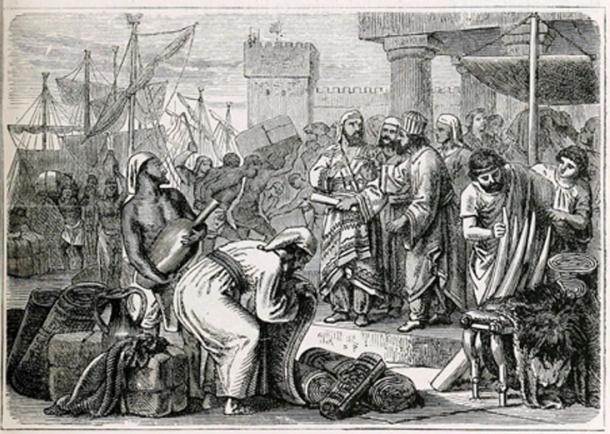
The Phoenicians flourished as marine merchants. (Baddu676 / Public Domain)
As mentioned before, the Greek ‘Phoiniki’ is associated with the dye known as Tyrian purple, which was traded by the Phoenicians. Indeed, this was one of the best-known products of Phoenicia. Tyrian purple was a highly-prized dye that was made using several species of sea snails belonging to the Muricidae family (commonly known as murex snails). One legend states that it was the Greek hero Hercules who discovered this dye. According to this tale, Hercules was strolling along the beach with a nymph, Tyrus, and his dog. Hercules’ dog came across a murex shell and devoured it. When the dog returned to its master its mouth was stained a brilliant purple.
Tyrus found the color so attractive that she requested from Hercules a robe of the of the same color as the price for her hand in marriage. Hercules obliged and gathered enough murex snails to produce the dye necessary to color Tyrus’ robe. In reality, however, Tyrian purple was discovered by the Phoenician. Although nobody is certain today as to how the dye’s discovery was made, it is entirely possible that it was accidental, similar to the Hercules story.
- 2,500-Year-Old Phoenician DNA Linked to Rare and Ancient European Ancestry
- Deciphering The Newton Stone’s Mysterious “Unknown Script”
- 3,500-Year-Old Advanced Minoan Technology Was ‘Lost Art’ Not Seen Again Until 1950s

The discovery of Tyrian purple, which was made famous by the Phoenicians. (Lomojo / Public Domain)
Tyrian purple was not the only trade object that the Phoenicians were famous for. Glass was another valuable product that the Phoenicians exported to the rest of the Mediterranean. Glass was already being produced by other civilizations including the Mesopotamians and Egyptians. The glass produced by these civilizations was colored and it is speculated that the Phoenicians were the first ones to produce transparent glass.
Yet another produce of Phoenicia was cedar wood, which the region is famous for, as far back as the Mesopotamian period. One of the main consumers of cedar wood during the 1 st millennium BC was Egypt, as the demand for wood by the Egyptians was greater than the local supply. Therefore, cedar wood was imported into Egypt from Phoenicia. During the 14 th century BC, for instance, the Phoenicians paid tribute to Egypt by offering cedar wood, as attested in the Amarna Letters.
The fame of the cedar wood from Phoenicia is also seen in the Story of Wenamun. In this Egyptian tale, Wenamun, a priest from the Amun Temple in Karnak sets off in a Phoenician ship to Byblos to purchase timber for the construction of a solar boat.
As superb seafarers, the Phoenician merchants need not rely solely on the goods locally produced in Phoenicia. They were more than capable of traveling to the far corners of the Mediterranean to obtain resources that they did not have back home. The most important of these were precious metals – tin and silver from Spain (and perhaps as far as Cornwall in England) and copper from Cyprus.
Colonies were set up along the trade routes in order to facilitate the journey of the Phoenician merchants. Moreover, Phoenicia is situated in a geographically strategic position that allowed it to further increase its wealth from trade.
The land of the Phoenicians is located between Mesopotamia in the east and Egypt and Arabia in the south / southwest. Trade routes between these two areas of the ancient world had to pass through Phoenicia thereby enriching the Phoenicians even further.
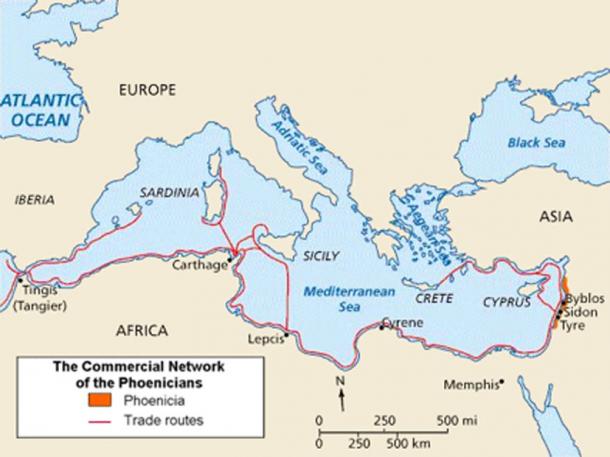
Map of Phoenicia and its Mediterranean trade routes. (Ras67 / CC BY-SA 3.0)
Did the Phoenicians Come Together as a Nation?
We do not know to whether the Phoenicians had a shared identity and if they considered themselves as a single nation. Nevertheless, we do know that they established city states which were politically independent.
The rise of these Phoenician city states occurred around 12th / 11th centuries BC. Around this time, the old powers that dominated the region, i.e. the Egyptians and the Hittites, had either been weakened or were destroyed. For instance, the arrival of the Sea Peoples led to the decline of the New Kingdom in Egypt, while the Hittite Empire was breaking up around the same time.
The Phoenicians seized the opportunity to fill the power vacuum left behind by these empires by establishing their own city states. It seems that each city state was ruled by a monarch, whose power was limited by a powerful oligarchy.
In addition, there is no evidence that the cities banded together into a federation. Instead, they operated independently. Among the most notable Phoenician city states were Tyre, Sidon, and Byblos.
Byblos (known today in Arabic as Jbail) is located about 30 kilometers (20 miles) to the north of modern day Beirut. Its history stretches way back before its rise as a powerful Phoenician city state during the 12th century BC.
Byblos is considered to be one of the oldest continuously inhabited cities in the world and according to the archaeological evidence was settled by human beings as early as the Neolithic period. By the 4th millennium BC Byblos had grown into an extensive settlement. Byblos became the main harbor from which cedar wood was exported to Egypt. As a result of this, the city developed into an important trade center.
Byblos became an Egyptian dependency during the first half of the 2nd millennium BC and maintained close ties with Egypt in the following centuries. With the decline and subsequent collapse of the Egyptian New Kingdom during the 11th century BC, Byblos became the leading city state in Phoenicia.
By around 1000 BC, however, Byblos was eclipsed by two other independent Phoenician city states, Sidon and Tyre. Like Byblos, Sidon (known today in Arabic as Saida) was already an ancient city by the time it became an independent city state.
Sidon was established during the 3rd millennium BC and prospered in the following millennium as a result of trade. On the other hand, Tyre (known today in Arabic as Sur) was probably originally founded as a colony of Sidon. Like Byblos and Sidon, Tyre too became an independent city state when the Egyptians lost their grip over that region.
In time, Tyre surpassed Sidon as the most important Phoenician city state as it traded and established its own colonies in other parts of the Mediterranean. According to tradition, the famous city of Carthage was established as a colony of Tyre in 814 BC.
- Rest Like an Egyptian: Lifting the Lid on the Elaborate Phoenician Tabnit Sarcophagus
- 2,700-year-old Phoenician Shipwreck Discovered in Maltese Waters
- Treasure trove of ancient Phoenician artifacts uncovered in Lebanon
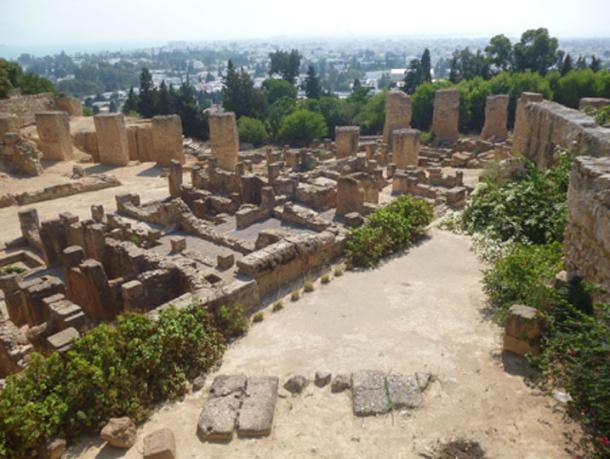
Archaeological site of Carthage, city established by the Phoenicians. (Eric00000007 / CC BY-SA 3.0)
Both Sidon and Tyre are also mentioned frequently in the Old Testament. For instance, the king of Tyre, Hiram, is recorded as providing Solomon the materials required for building the temple in Jerusalem.
The Phoenicians Lose Their Independence
The Phoenician city states were not able to hold on to their independence for long. The wealth of these city states must have attracted the attention of foreign powers. During the 8 th and 7 th centuries BC, the Phoenician city states came under the rule of the Neo-Assyrian Empire.
In 538 BC, Phoenicia was conquered by Cyrus the Great and came under Persian rule. Although the Phoenicians had lost their independence their cities continued to flourish.
Due to their expertise in seafaring, the Phoenicians supplied ships for the Persian kings. Persian rule over Phoenicia ended during the 4th century BC, when the region fell to Alexander the Great.
One of the major battles of Alexander’s campaign against the Persian Empire was the Siege of Tyre, which occurred in 332 BC. As the naval base of the Persians, Alexander knew that it would be unwise to leave it in the hands of the enemy as he continued his campaign southwards. He was also aware that Tyre would not fall so easily, as it was situated on an island off the mainland and was heavily fortified.
Therefore, he requested permission to offer sacrifices at the Temple of Melqart, the Phoenician god identified with the Greek hero Heracles, in the hopes that he would be allowed to enter the city. Alexander’s request was rejected, so he sent heralds to issue an ultimatum to the Tyrians – surrender or be conquered. In response, the Tyrians killed the heralds and threw them off the city walls.
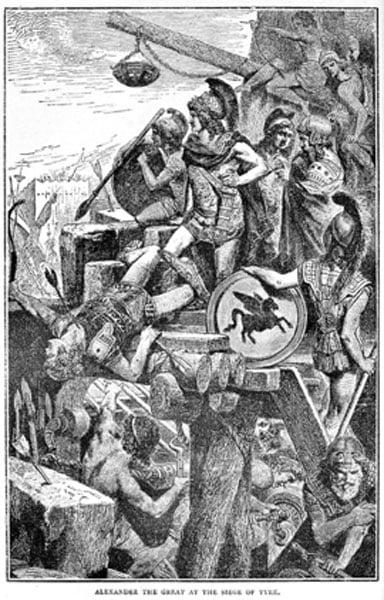
Alexander the Great at the Siege of Tyre attacking the Phoenicians. (पाटलिपुत्र / Public Domain)
Enraged by the Tyrian’s defiance, Alexander proceeded to besiege the city. Due to the lack of a naval force the Macedonians were unable to assault the city directly. Instead, Alexander’s engineers began building a causeway to connect the island to the mainland. The Tyrians in turn sought to hamper the construction of the causeway, which was successful, until the arrival of a fleet of ships from Cyprus, as well as those that defected to Alexander from the Persians.
Eventually, the causeway was completed, and the Macedonians stormed and captured the city. The entire siege lasted seven months. Still furious with the Tyrians, Alexander executed about 10,000 of the city’s inhabitants, while another 30,000 were sold into slavery.
In the years following the death of Alexander the Great, Phoenicia was one of the regions fought over by the Seleucids and the Ptolemies, two of Alexander’s successors. During this period, the Phoenicians were gradually Hellenized, and their original identity was slowly being replaced. Finally, Phoenicia was incorporated by Pompey as part of the Roman province of Syria in 65 BC.
Although the Phoenicians disappeared from the pages of history, they are still remembered today as expert seafarers and merchants. This reputation, however, pales in comparison to the greatest contribution made by the Phoenicians to the modern world – the alphabet.
Like much of the Middle East during that time, the Phoenicians used a script known as cuneiform which originated in Mesopotamia. By around 1200 BC the Phoenicians had developed their own script. The earliest known example of the Phoenician script is found on the Sarcophagus of Ahiram, which was discovered in Byblos.
The Phoenician alphabet was later adopted by the Greeks who kept some characters while removing others. The Greek alphabet was in turn adopted by the Romans resulting in its spread all across Europe. Additionally, the Phoenician alphabet is considered to be the basis of other Middle Eastern, as well as Indian alphabets, either directly or indirectly.
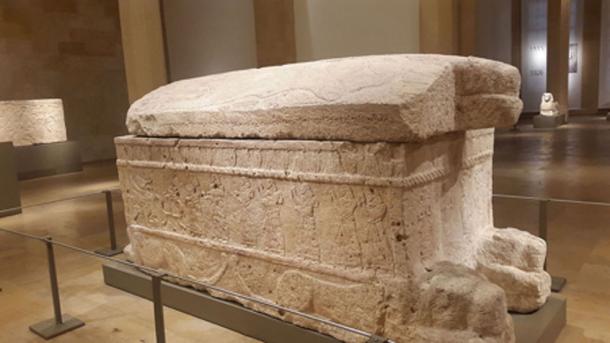
Sarcophagus of Ahiram with Phoenician writing. (Emnamizouni / CC BY-SA 4.0)
Top image: Phoenician stone sculpture (disq / Adobe Stock)
By Wu Mingren
References
Aramco Services Company. 1960. Tyrian Purple. [Online] Available at: https://archive.aramcoworld.com/issue/196007/tyrian.purple.htm
Hickman, K. 2017. Wars of Alexander the Great: Siege of Tyre. [Online] Available at: https://www.thoughtco.com/alexander-the-great-siege-of-tyre-2360867
Hunt, P. 2019. Carthage. [Online] Available at: https://www.britannica.com/place/Carthage-ancient-city-Tunisia
New World Encyclopedia. 2019. Phoenician Civilization. [Online] Available at: https://www.newworldencyclopedia.org/entry/Phoenician_Civilization
Schumm, L. 2018. Who created the first alphabet?. [Online] Available at: https://www.history.com/news/who-created-the-first-alphabet
The Editors of Encyclopaedia Britannica. 1998. Ghassulian culture. [Online] Available at: https://www.britannica.com/topic/Ghassulian-culture
The Editors of Encyclopaedia Britannica. 2007. Byblos. [Online] Available at: https://www.britannica.com/place/Byblos
The Editors of Encyclopaedia Britannica. 2014. Sidon. [Online] Available at: https://www.britannica.com/place/Sidon
The Editors of Encyclopaedia Britannica. 2015. Tyre. [Online] Available at: https://www.britannica.com/place/Tyre
The Editors of Encyclopaedia Britannica. 2019. Phoenicia. [Online] Available at: https://www.britannica.com/place/Phoenicia
The Metropolitan Museum of Art. 2004. The Phoenicians (1500–300 B.C.). [Online] Available at: https://www.metmuseum.org/toah/hd/phoe/hd_phoe.htm
TimeMaps Ltd. 2019. The Phoenicians. [Online] Available at: https://www.timemaps.com/civilizations/phoenicians/
Waterfield, R. (trans.). 1998. Herodotus’ The Histories. Oxford: Oxford University Press.
www.touregypt.net. 2019. Wenamen's Journey. [Online] Available at: http://www.touregypt.net/wenamensjourney.htm
















Comments
Hi All,
Wow, The Bible just got confirmed since Canaan The Land of The Canaanites is mentioned numerous Time's through out Genesis & Jubilees.
It was exciting too read about Tyre & Sidon.
In 1st King's of The Bible Sidon is The Kingdom Queen Jezebel King Ahab's Wife hailed from a devout worshipers of the gods in her country Baal & Ashera; which was why Ahab shouldn't have married her to begin with, but that's a story for another Time.
Which makes Jezebel and her people Phonecians.
I do know in The Gospel's such as Matthew & Luke Jesus for tells that it would be more Bearable for The People of Sodom, Sidon, & Tyre on The Day of Judgment than for this generation.
I was under the mistaken impression that The Canaanites were all extinct; until, I saw a Jeopardy Episode back when Alex Trebek was still with Us an learned that The Canaanites did still exist They all live in present Day Lebanon.
My memory serves from Sunday School then later Sabbath School The Canaanites are Ancestor's of A Man named Canaan.
The significance Canaan was Ham's youngest Son and the Subject of Biblical Scholarly Debate whether A Drunken Noah curse only affected Canaan are all of Canaans sibling's. The Biblical Reference was used to justify The African Enslavement/Colonialism of Africa.
Clearly those people weren't reading The Scriptures Right because they always say Ham got cursed, Ham didn't get cursed Canaan and his Sibling's got Cursed.
For the record Ham & his Wife couldn't be Cursed because when they exited The Ark and made the sacrifice too God in response God Blessed Them being Blessed meant Ham was untouchable with Noah's Curse so that's why Canaan wound up getting Cursed.
An yet as I've stated Earlier Those same Canaanites thrive in Lebanon Today.
That's all I wish too share in this discussion about The Phonecians so until next Discussion regarding another Subject or Topic everyone Goodbye!
Hi All,
Wow, The Bible just got confirmed since Canaan The Land of The Canaanites is mentioned numerous Time's through out Genesis & Jubilees.
It was exciting too read about Tyre & Sidon.
In 1st King's of The Bible Sidon is The Kingdom Queen Jezebel King Ahab's Wife hailed from a devout worshipers of the gods in her country Baal & Ashera; which was why Ahab shouldn't have married her to begin with, but that's a story for another Time.
Which makes Jezebel and her people Phonecians.
I do know in The Gospel's such as Matthew & Luke Jesus for tells that it would be more Bearable for The People of Sodom, Sidon, & Tyre on The Day of Judgment than for this generation.
I was under the mistaken impression that The Canaanites were all extinct; until, I saw a Jeopardy Episode back when Alex Trebek was still with Us an learned that The Canaanites did still exist They all live in present Day Lebanon.
My memory serves from Sunday School then later Sabbath School The Canaanites are Ancestor's of A Man named Canaan.
The significance Canaan was Ham's youngest Son and the Subject of Biblical Scholarly Debate whether A Drunken Noah curse only affected Canaan are all of Canaans sibling's. The Biblical Reference was used to justify The African Enslavement/Colonialism of Africa.
Clearly those people weren't reading The Scriptures Right because they always say Ham got cursed, Ham didn't get cursed Canaan and his Sibling's got Cursed.
For the record Ham & his Wife couldn't be Cursed because when they exited The Ark and made the sacrifice too God in response God Blessed Them being Blessed meant Ham was untouchable with Noah's Curse so that's why Canaan wound up getting Cursed.
An yet as I've stated Earlier Those same Canaanites thrive in Lebanon Today.
That's all I wish too share in this discussion about The Phonecians so until next Discussion regarding another Subject or Topic everyone Goodbye!
Hi All,
Wow, The Bible just got confirmed since Canaan The Land of The Canaanites is mentioned numerous Time's through out Genesis & Jubilees.
It was exciting too read about Tyre & Sidon.
In 1st King's of The Bible Sidon is The Kingdom Queen Jezebel King Ahab's Wife hailed from a devout worshipers of the gods in her country Baal & Ashera; which was why Ahab shouldn't have married her to begin with, but that's a story for another Time.
Which makes Jezebel and her people Phonecians.
I do know in The Gospel's such as Matthew & Luke Jesus for tells that it would be more Bearable for The People of Sodom, Sidon, & Tyre on The Day of Judgment than for this generation.
I was under the mistaken impression that The Canaanites were all extinct; until, I saw a Jeopardy Episode back when Alex Trebek was still with Us an learned that The Canaanites did still exist They all live in present Day Lebanon.
My memory serves from Sunday School then later Sabbath School The Canaanites are Ancestor's of A Man named Canaan.
The significance Canaan was Ham's youngest Son and the Subject of Biblical Scholarly Debate whether A Drunken Noah curse only affected Canaan are all of Canaans sibling's. The Biblical Reference was used to justify The African Enslavement/Colonialism of Africa.
Clearly those people weren't reading The Scriptures Right because they always say Ham got cursed, Ham didn't get cursed Canaan and his Sibling's got Cursed.
For the record Ham & his Wife couldn't be Cursed because when they exited The Ark and made the sacrifice too God in response God Blessed Them being Blessed meant Ham was untouchable with Noah's Curse so that's why Canaan wound up getting Cursed.
An yet as I've stated Earlier Those same Canaanites thrive in Lebanon Today.
That's all I wish too share in this discussion about The Phonecians so until next Discussion regarding another Subject or Topic everyone Goodbye!
Hi All,
Wow, The Bible just got confirmed since Canaan The Land of The Canaanites is mentioned numerous Time's through out Genesis & Jubilees.
It was exciting too read about Tyre & Sidon.
In 1st King's of The Bible Sidon is The Kingdom Queen Jezebel King Ahab's Wife hailed from a devout worshipers of the gods in her country Baal & Ashera; which was why Ahab shouldn't have married her to begin with, but that's a story for another Time.
Which makes Jezebel and her people Phonecians.
I do know in The Gospel's such as Matthew & Luke Jesus for tells that it would be more Bearable for The People of Sodom, Sidon, & Tyre on The Day of Judgment than for this generation.
I was under the mistaken impression that The Canaanites were all extinct; until, I saw a Jeopardy Episode back when Alex Trebek was still with Us an learned that The Canaanites did still exist They all live in present Day Lebanon.
My memory serves from Sunday School then later Sabbath School The Canaanites are Ancestor's of A Man named Canaan.
The significance Canaan was Ham's youngest Son and the Subject of Biblical Scholarly Debate whether A Drunken Noah curse only affected Canaan are all of Canaans sibling's. The Biblical Reference was used to justify The African Enslavement/Colonialism of Africa.
Clearly those people weren't reading The Scriptures Right because they always say Ham got cursed, Ham didn't get cursed Canaan and his Sibling's got Cursed.
For the record Ham & his Wife couldn't be Cursed because when they exited The Ark and made the sacrifice too God in response God Blessed Them being Blessed meant Ham was untouchable with Noah's Curse so that's why Canaan wound up getting Cursed.
An yet as I've stated Earlier Those same Canaanites thrive in Lebanon Today.
That's all I wish too share in this discussion about The Phonecians so until next Discussion regarding another Subject or Topic everyone Goodbye!
Evidence suggests that the ancient Greek people, in a generic sense, were the aboriginals/Neanderthal who probably had already carved out the catacombs and erected much if not all of the megalith stone cultural centers that were already in ruin by the time the Sumerians arrived (and began building over them with mud bricks). Of course we know of Plato’s knowledge of Atlantis, probably via oral history, as nothing was left of it by his time. Most likely it was the place now called the Richat Structure, which would have been a nice estuary just prior to the sudden onset of the Ice Age around 115,000 years ago (adding the zero back to Plato’s timeline). That’s the place where the maritime culture of the Atlantic/Med would have evolved – although now a barren-dry desert that might just need some digging. The Atlanteans would likely have had a written language, probably similar to ancient Greek/Doric (with ‘Phoenician script’). But the archaeological problem, other than lack of interest in digging up the Richat Structure valley, is the gap between before the Ice Age and when the ruins were resettled by survivors of that global calamity and the new arrivals, e.g.,, children of the Sumerians (Semitic/Persian types), the self-described black-headed people, said (by Sitchin, etc.) to have come to Earth from another planet, certainly with their own spoken language – and represented in the ancient cuneiform script, later called Semitic languages generically. Semites, as ancient Greeks called them, semi-man, or half-breeds, children of the alien men and aboriginal women. Lot of diversion and deception in the field, concealing a seemingly unmentionable ugliness/tragedy/crime that fell upon that earlier, fair-haired Atlantean civilization.
Nobody gets paid to tell the truth.
Pages